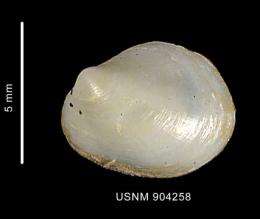© Smithsonian Institution, National Museum of Natural History, Department of Invertebrate Zoology
(Phys.org)—Researchers from Britain's National Oceanography Centre, Southampton, working in the Antarctic have discovered that a species of mollusk, Lissarca miliaris, changes from male to female as it grows older. As the team describes in their paper published in the journal Polar Biology, the males harbor eggs when they are young then grow female sex organs as they grow older to allow for brooding.
Previous studies of the reproductive process of the mollusk had focused almost exclusively on the adult female and because of that had missed the hermaphrodite traits this new team uncovered.
In studying young males, the team found that they held within them, multiple eggs, more than they could every possibly brood as they are still quite small at that age. In looking at other specimens they found that as the males grow older they grow female organs that allow for proper development of the eggs and brooding. The team suspects that the mollusks reproduce as males, then switch over to being female when they are large enough to brood the huge numbers (up to 70) of young that have been produced. They also found that the male organs appear to hang around for quite some time after the female organs have developed.
Mollusks, part of a group of bivalves, hold their young inside their shells while brooding, a technique the researchers say is common in the cold Antarctic climate, and other mollusks have been known to exhibit hermaphrodite features as well. Keeping the young inside requires less energy and resources to keep offspring alive while growing. The eggs are described as quite yolky and the young develop quite slowly.
The team theorizes that having the males produce eggs allows for the long time span, up to 18 months, it takes for the offspring to mature. Under such an arrangement, mating can occur when the mollusks are still very young, and then have room to develop as the male sex organs give way to female and the amount of room inside the shell grows. They also note that their findings show just how little is known about invertebrates living in the Antarctic and how much there still is to discover.
More information: An unusual hermaphrodite reproductive trait in the Antarctic brooding bivalve Lissarca miliaris (Philobryidae) from the Scotia Sea, Southern Ocean, Polar Biology, 2012, DOI: 10.1007/s00300-012-1233-0
Abstract
The Antarctic marine environment is extreme in its low temperatures and short periods of primary productivity. Invertebrates must therefore adapt to maximise reproductive output where low temperature and limited food slow larval development. Brooding is a common reproductive trait in Antarctic marine bivalves; larval development occurs within the mantle cavity, and larvae are released as fully developed young. Lissarca miliaris is a small, short-lived, shallow-water brooding bivalve of circum-Antarctic distribution and found most abundant in the sub-Antarctic Magellan Region and islands of the Scotia Arc. Here, an unusual hermaphrodite reproductive trait is described for L. miliaris from King George Island (62°14′S, 58°38′W) and Signy Island (60°42′S, 45°36′W), Antarctica, using histological and dissection techniques. Specimens demonstrate simultaneous and sequential hermaphrodite traits; male and female gonads develop simultaneously, but the production of oocytes is reduced while testes are ripe. Functional females are more abundant in specimens above 3 mm shell length, although male reproductive tissue persists and functional males are found in all size classes. The number of previtellogenic oocytes produced by far exceeds the number of oocytes extruded and brooded, which may indicate an ancestral link to a planktotrophic past. Hermaphroditism in L. miliaris maximises reproductive efficiency in a short-lived species, in which the female's capacity to brood its young is limited, and demonstrates a specialised adaptation to a cold stenothermal and food-limited environment prevailing in the Southern Ocean.
© 2012 Phys.org






















